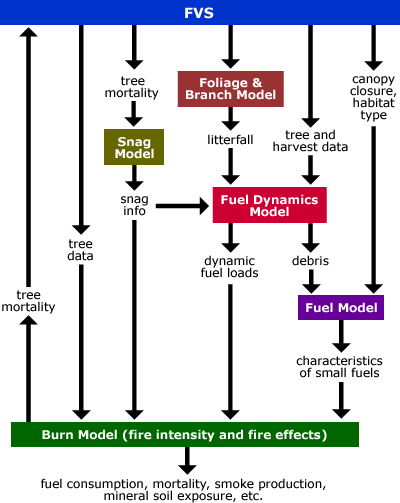The Fire & Fuel Effects Model for Forest Planning
ESSA’s forest scientists worked with colleagues at the US Forest Service to develop the Fire & Fuel Effects model (FFE) for the contiguous US; which supports strategic planning by simulating the interaction of fire with stand growth and structure, predicting fire intensity, carbon, smoke and mortality.
 Fire is a natural part of all forested ecosystems, but with a long history of fire suppression throughout most of North America and a drier warmer climate, fire conditions have become more extreme in many places. These conditions can be aggravated when coupled with periodic outbreaks of defoliating insects, which can greatly alter the fuel profile. To manage these risks, forest and fire managers need to characterize stand conditions so that they can identify high risk stands (especially near communities) and identify treatments that will reduce the risk and consequences of extreme fires.
Fire is a natural part of all forested ecosystems, but with a long history of fire suppression throughout most of North America and a drier warmer climate, fire conditions have become more extreme in many places. These conditions can be aggravated when coupled with periodic outbreaks of defoliating insects, which can greatly alter the fuel profile. To manage these risks, forest and fire managers need to characterize stand conditions so that they can identify high risk stands (especially near communities) and identify treatments that will reduce the risk and consequences of extreme fires.
The Fire and Fuels Extension (FFE) meets many of these needs. It begins with elements of existing fire behaviour and fire-effects models (such as FIREMOD and FOFEM) and links those to the Forest Vegetation Simulator (FVS), the Forest Service model which simulates tree growth and mortality and stand management. Over a period of about five years all 22 geographic variants of FVS were linked to the FFE and adapted using localized knowledge of fire behaviour. The model was also linked to the BC variant of FVS for exploratory purposes. The FFE simulates actual and potential fire behaviour and effects, including fuel consumption, crowning, tree mortality, smoke production and changes to above-and below-ground carbon stocks and fluxes. Over the past decade US Forest Service staff have trained hundreds of federal and state foresters and other fire professionals to use the FVS-FFE as a part of fire and fuel treatment planning. In BC, the Wildfire Management Branch has supported application of the FFE to explore fire behaviour in different stand types.
Inputs into the Fire & Fuel Effects Model and resulting simulation visualization

Keywords & Themes: Terrestrial resources / Fire / Disaster risk reduction / Hazard assessment / Data management / State transition models / Forest management / Geospatial tools / Data visualization
Key Contacts
Don Robinson
Senior Systems Ecologist

